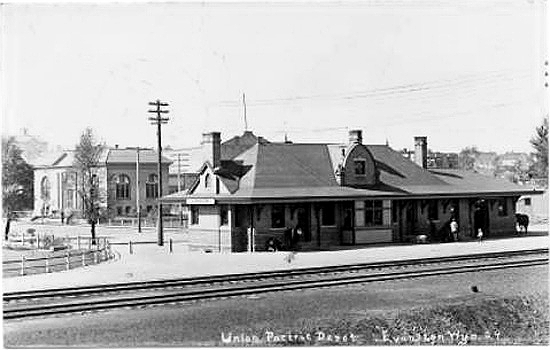
Evanston Depot, 1910
The depot to the right was constructed
in 1901, replacing an earlier depot opened in June 1869. It had two waiting rooms,
one for the ladies with fireplace and one for the men with a potbellied stove.
Behind the depot at the intersection of 10th Street and Front Street
is the Carnegie Library constructed in 1906. The Depot
was donated to the City by the Union Pacific and the plaza in front is used
for community functions. The library building now houses the Chamber of Commerce and
a museum.
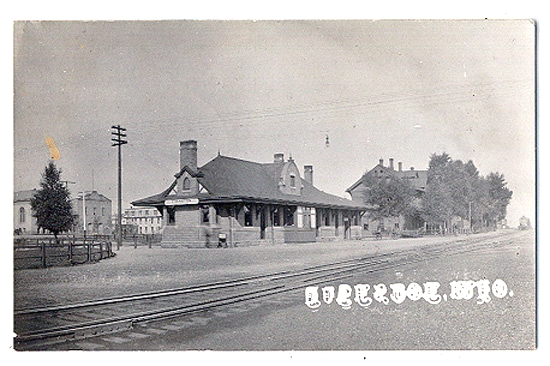
Evanston Depot, approx. 1910
Other early buildings on Front Street included an Opera House constructed in
1885. With the coming of the Lincon Highway, it was converted into the Transcontinental Garage in 1923
(see next page).
As indicated with regard to the discussion of
Rawlins, the early highways were a bit rough and not well marked. Harriet
White Fisher in her passage through Evanston in 1909 stopped and asked directions of a
local lawyer, Payson Wilson Spaulding (1876-1972). Fortunately, Spaulding was familiar
with the route since he was the owner of the first motor car in Evanston. In
1906, Spaulding drove from Evanston to Cheyenne and back just to prove it could
be done. As a lawyer, Spaulding remained in active practice into his late 80's, in fact,
taking a case to the Wyoming Supreme Court in 1965 when he was 89 years old.
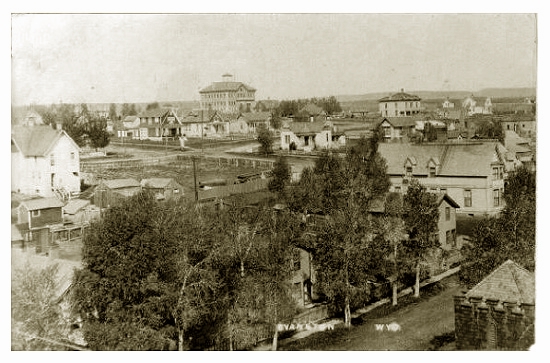
Evanston, residential district, 1908.
The house with the two dormers and bay windows was Pine Gables, the residence of Anthony V. Quinn, vice president
of Beckwith, Quinn & Company. The house was constructed in 1883. In the
1920 it was converted to a tourist home. It is now on the National
Register and is a bed and breakfast.
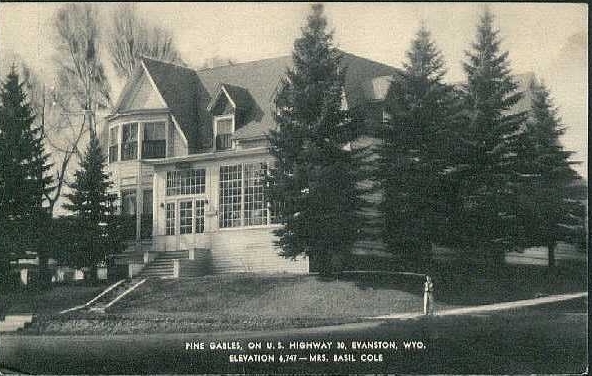
Pine Gables, 1930's
Quinn left home in Illinois in 1850 to join the gold rush to
California. With the construction of the Pacific Railroad, he was employed as
a superintendent of mines until joining A. C. Beckwith & Company.
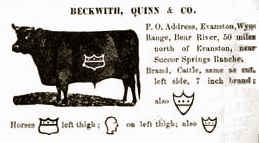
Beckwith and Quinn Brands
Beckwith, Quinn & Co. served as
a labor contractor for Chinese workers in the Union Pacific Coal Mines, operated a mercantile
business and operated ranches in both Wyoming and Arizona. In addition to
cattle, the ranches raised Kentucky thoroughbreds and trotters. Anahel Collins
Beckwith had the distinction of having served one of the shortest terms as a
United States Senator. He was appointed Senator by Governor John E. Osborne on
March 4, 1893, and resigned on July 11, 1893, never having been seated. The end result is that
David Bratman of Stanford University lists Beckwith as a United States Senator,
Professor T. A. Larson makes note of Beckwith's non-service, and the Wyoming Secretary of
State ignores him completely. The failure of the Senate to seat Beckwith was part of an
ongoing dispute which resulted in Wyoming having only one senator during the
Osborne administration. Indeed, Gov. Osborne cancelled plans to attend the inauguration of
President Cleveland out of fear that during his absence from the state, Republican
Secretary of State Amos W. Barber, as acting governor, would appoint a Republican who would be
promptly seated by the Republican controlled Senate.
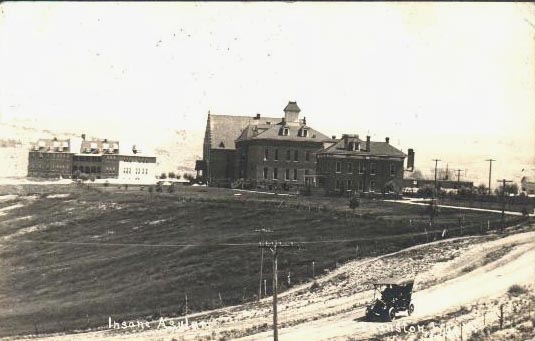
Wyoming State Hospital, 1913
Wyoming, from its very beginnings, has had
a concern for the proper treatment of the mentally ill. Its first territorial
legislature passed an act providing for the care of the mentally disturbed in asylums
in the east. The first portions of the Wyoming State Hospital were completed in 1888.
Later additions consisting of dormatory buildings were designed by Cheyenne architect
William R. Dubois. For further information as to Dubois see Cheyenne.
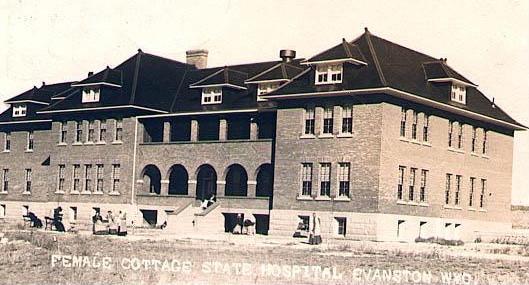
Female Cottage, Wyoming State Hospital, Evanston, undated
Reasons for admission to the hospital in its early years varied. The report to
the State Board of Charities for the fiscal year ending September 1897 noted that
in the previous year 23 persons had been admitted. The precipitating causes for
the mental diseases were listed. Five men were admitted for
intemperance. One man and one woman were each admitted because of "vicious habits."
One man and one woman were each admitted because of "business worry." One woman's
mental problems were brought about because of "grief" and another because of a
seduction.
Next page, Evanston continued.
|